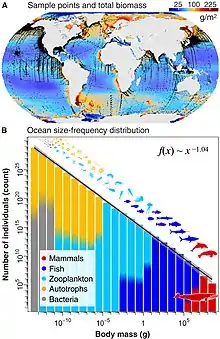
The Sheldon spectrum is an empirically-observed feature of marine life by which the size of an organism is inversely correlated with its abundance in the ocean. The spectrum is named after Ray Sheldon, a marine ecologist at Canada’s Bedford Institute of Oceanography in Dartmouth, Nova Scotia. Sheldon and colleagues first suggested the existence of the inverse correlation based on seagoing measurements of plankton made with a Coulter counter in the late 1960s, most notably during the first circum-navigation of the Americas aboard the CCGS Hudson.[1]
The inverse correlation implies that biomass density as a function of logarithmic body mass is approximately constant over many orders of magnitude.[2] For example, when Sheldon and his colleagues analyzed a plankton sample in a bucket of seawater, they would tend to find that one third of the plankton mass was between 1 and 10 micrometers, another third was between 10 and 100 micrometers, and a third was between 100 micrometers and 1 millimeter. To make up for the differences of size, there must be a remarkably accurate mathematically correlative decrease in number of organisms as they become larger, in order for the biomass to remain constant. Thus, the rule predicts that krill which are a million times smaller than tuna are a million times more abundant in the ocean, a prediction which appears to be true. [3]
There is strong evidence that human behavior, particularly overfishing and whaling, have modified the Sheldon spectrum for larger species, and it is unknown what long term effects such global alteration may have.[4]
References
- ↑ Sheldon et al., The size distribution of particles in the ocean, Limnology and Oceanography 1972, 17(3)
- ↑ Cuesta JA, Delius GW, Law R. Sheldon spectrum and the plankton paradox: two sides of the same coin—a trait-based plankton size-spectrum model, Journal of Mathematical Biology 2018;76:67-96
- ↑ Matt Reynolds (November 23, 2021) Humans Have Broken a Fundamental Law of the Ocean, Wired Retrieved November 24, 2021
- ↑ Hatton IA, et al. The global ocean size spectrum from bacteria to whales, Science Advances 2021;7(46)